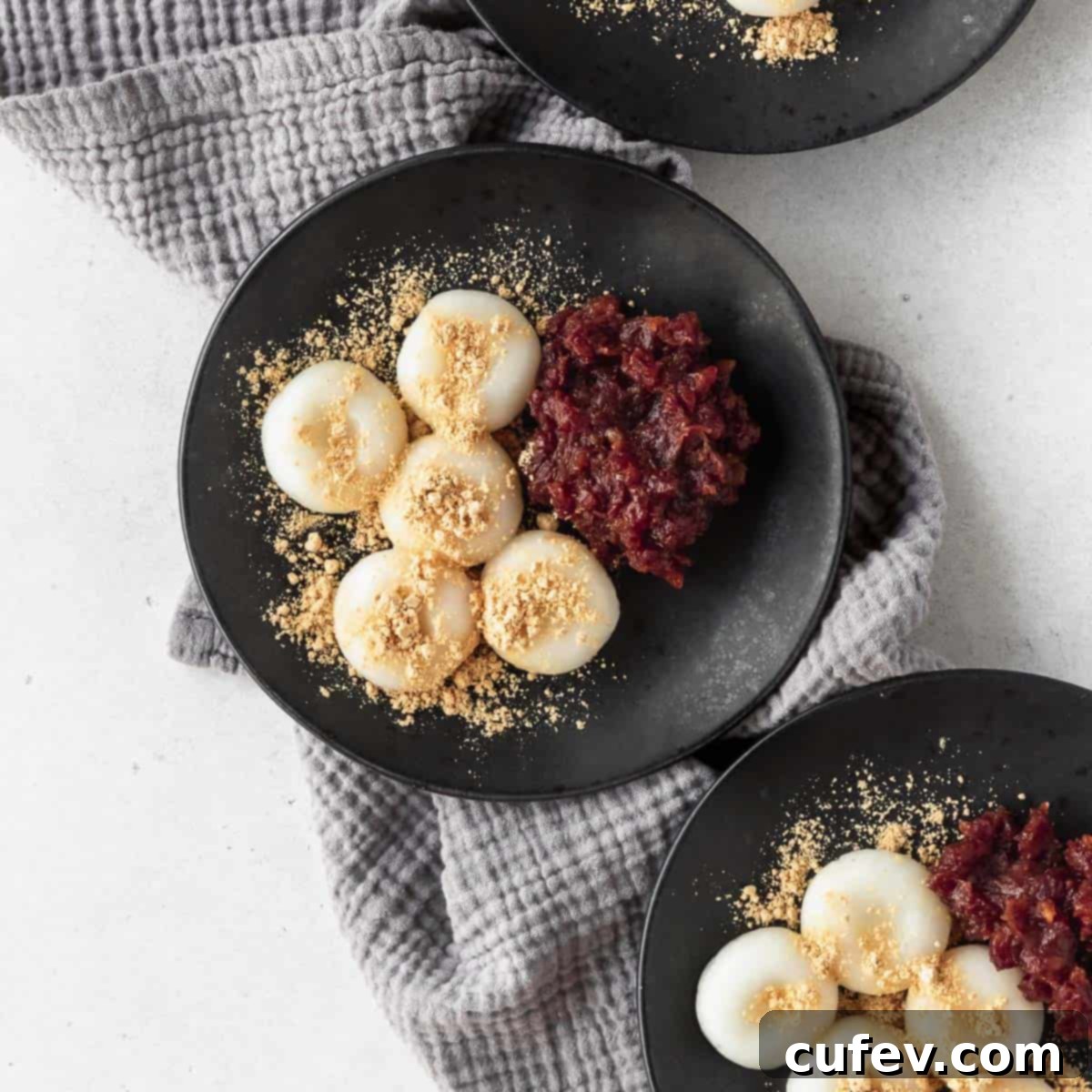Easy Homemade Shiratama Dango Recipe: Chewy Japanese Sweet Mochi Dumplings
If you have a fondness for traditional Japanese sweets, prepare to fall in love with these incredibly delightful shiratama dango! These soft, chewy, and subtly sweet mochi-like dumplings are a staple in Japanese cuisine, offering a unique texture and a gentle flavor that pairs beautifully with a variety of accompaniments. Often served alongside classic toppings like rich sweet red bean paste (anko), fragrant kinako powder (roasted soybean flour), or even nestled next to a scoop of creamy ice cream, shiratama dango are a versatile treat perfect for any occasion.
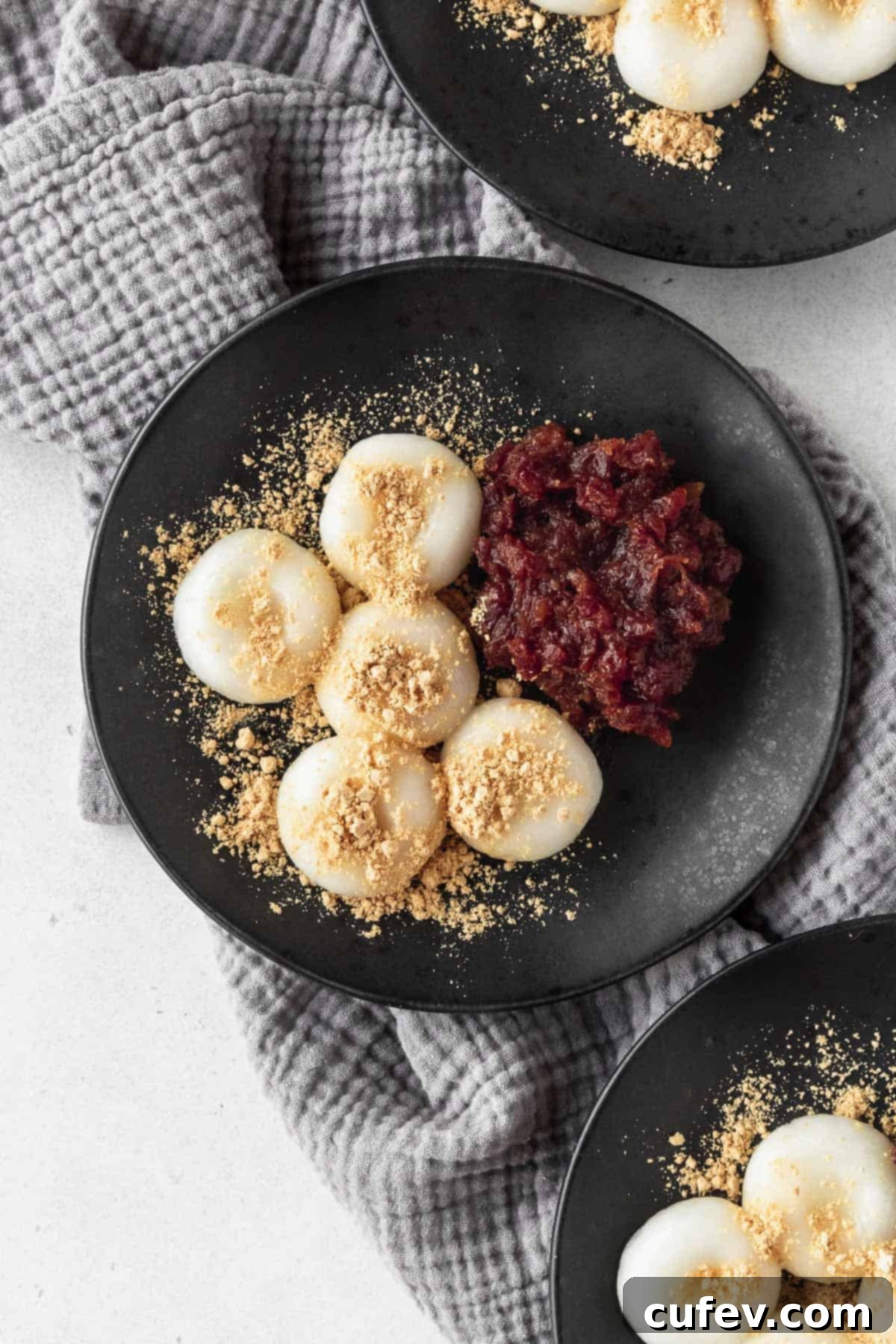
This beloved recipe was initially published on June 9, 2020, and has since been updated with fresh photos and enhanced information on January 27, 2023, to bring you the most comprehensive and user-friendly guide to making perfect shiratama dango at home.
Table of Contents
- What Are Shiratama Dango? Understanding These Japanese Mochi Dumplings
- The Difference Between Shiratamako and Mochiko Flour
- Why You’ll Adore This Easy Shiratama Dango Recipe
- Essential Ingredients & Clever Substitutions
- Step-by-Step: How to Make Perfect Shiratama Dango
- Using Mochiko Rice Flour for Dango: A Guide
- Expert Tips for Flawless Shiratama Dango
- Delightful Serving Suggestions for Your Dango
- Storage and Freezing Techniques for Longevity
- Reheating and Softening Stored Shiratama Dango
- Frequently Asked Questions About Shiratama Dango
- Tools You’ll Need for Your Shiratama Dango
- Explore More Japanese & Japanese-Inspired Desserts
What Are Shiratama Dango? Understanding These Japanese Mochi Dumplings
Shiratama dango (白玉団子) are a delightful variety of wagashi, which are traditional Japanese confections. Made primarily from shiratamako, a specific type of sweet glutinous rice flour, these dumplings boast a uniquely soft, incredibly chewy, and slightly stretchy texture that sets them apart. Unlike many Western desserts, shiratama dango possess only a subtle, natural sweetness derived from the rice flour itself, making them an ideal canvas for various sweet or even savory toppings.
In Japan, the versatility of shiratama dango is highly appreciated. Their mild flavor ensures they never overpower the accompanying ingredients but instead enhance them with their satisfying chewiness. Common ways to enjoy them include a simple sprinkle of nutty kinako (roasted soybean powder) and a drizzle of rich kuromitsu (Japanese black sugar syrup). They are also a fantastic addition to warm, sweet red bean soups like zenzai or oshiruko, where their texture provides a delightful contrast. During warmer months, shiratama dango become an especially popular garnish, adding a beautiful presentation and a delightful textural element to ice creams, parfaits, and fruit salads, making them truly perfect for summer indulgences.
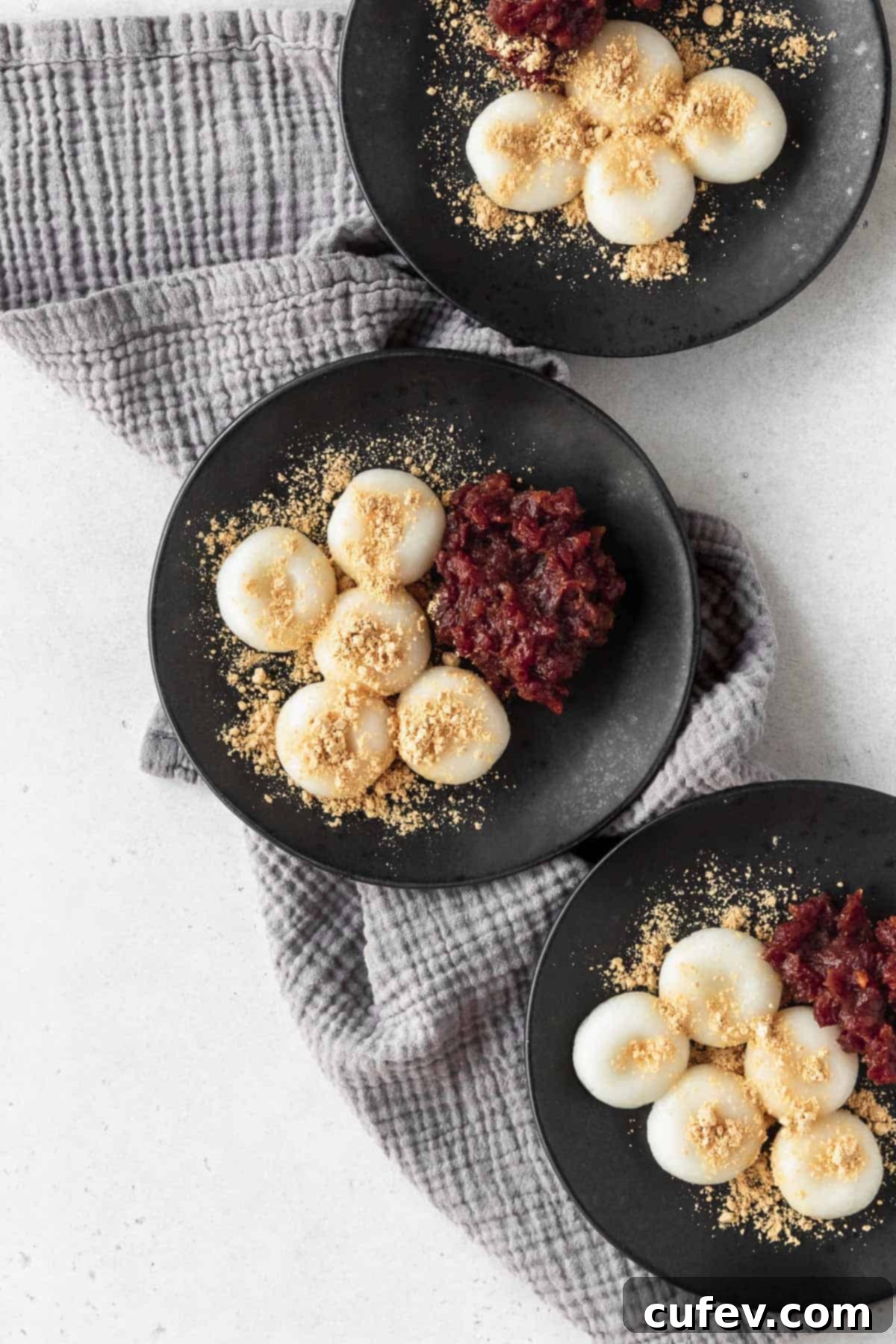
The Difference Between Shiratamako and Mochiko Flour
While both shiratamako and mochiko are types of glutinous rice flour derived from mochigome (sweet or sticky rice), their distinct processing methods lead to noticeable differences in the texture of the finished mochi products. Understanding these nuances is key to achieving the desired consistency for your dango.
Shiratamako rice flour is traditionally produced through a meticulous process: polished sticky rice is rinsed thoroughly, then ground into a fine paste. This paste is then allowed to settle, and the starchy sediment is carefully collected and dried. This unique wet-milling process results in a coarser, more granular flour that, when hydrated, yields a mochi dough that is exceptionally smooth, elastic, and has a pleasant, soft chew. Shiratama dango made with shiratamako are renowned for their silky texture and glossy appearance.
In contrast, mochiko flour is typically made by simply drying and then finely pulverizing polished sticky rice. This dry-milling method produces a very fine, powdery flour. While mochiko is more widely available and often used for various mochi applications, dango made with mochiko tend to be chewier and firmer, sometimes lacking the smooth, tender resilience characteristic of traditional shiratama dango. They might also have a slightly stronger, more pronounced sticky rice flavor. For the classic shiratama texture, shiratamako is undeniably the superior choice.

Why You’ll Adore This Easy Shiratama Dango Recipe
Beyond their undeniably delicious taste and captivating texture, these homemade shiratama dango offer a multitude of reasons to become your new favorite Japanese dessert. This recipe is specifically designed to be accessible and enjoyable for home cooks of all skill levels, delivering fantastic results every time.
- Quick & Easy: You’ll be astonished at how straightforward and swift it is to make these traditional Japanese mochi dumplings. Requiring just two basic ingredients and approximately 10 minutes from start to finish, this recipe is perfect for a spontaneous sweet craving or a last-minute addition to a meal. Forget complicated steps; this is simplicity at its finest.
- Not Too Sweet: One of the most appealing aspects of shiratama dango is their subtle sweetness. Unlike many desserts that can be overly cloying, the inherent sweetness in these dumplings comes directly from the sweet rice flour itself. This allows them to be enjoyed without overwhelming your palate, and critically, makes them adaptable to a wide array of toppings, from intensely sweet to lightly savory.
- Incredibly Versatile: Because the dango recipe itself is intentionally unsweetened, it offers unparalleled versatility. You can tailor your serving experience to your exact mood or seasonal preference. Pair them with rich red bean paste for a traditional indulgence, a light dusting of kinako, fresh fruit, or even a savory touch if you’re feeling adventurous. The possibilities are truly endless, making them a dessert that never gets boring.
- Delightfully Chewy & Stretchy: The texture of shiratama dango is pure joy! If you’re a fan of treats with a soft, bouncy, and satisfyingly chewy mouthfeel, these dumplings will hit all the right notes. Each bite provides a pleasing resistance that makes them incredibly fun to eat and a unique experience compared to other desserts. Their springiness is a hallmark of authentic Japanese mochi.
Essential Ingredients & Clever Substitutions
One of the beauties of this shiratama dango recipe lies in its minimal ingredient list, making it an accessible treat to whip up anytime. Here’s a closer look at what you’ll need and potential adjustments:
- Shiratamako: This is the star ingredient and truly non-negotiable for authentic shiratama dango. As discussed, shiratamako, a specific type of glutinous sweet rice flour, provides that distinctively smooth, soft, and chewy texture that sets shiratama dango apart. You can typically find shiratamako at Japanese grocery stores, Asian supermarkets, or increasingly, online specialty food retailers. Do not confuse it with mochiko or regular rice flour, as the results will be different.
- Water: Simple tap water is all you need to hydrate the shiratamako and transform it into a pliable dough. The amount of water is crucial for the perfect consistency, so adding it gradually is key. For an interesting variation that yields an even softer, almost melt-in-your-mouth dango, some enthusiasts prefer to use soft silken tofu instead of, or in combination with, water. The tofu adds a subtle richness and an incredibly delicate texture, making for an extra-special mochi. If trying this, blend the silken tofu first until completely smooth, then incorporate it as you would water.
- Toppings: While the dango themselves are lightly flavored, the toppings are where you can truly customize your experience. My personal favorites are creamy sweet red bean paste (anko) and aromatic kinako (roasted soybean powder). Other popular choices include a drizzle of kuromitsu (black sugar syrup), maple syrup, fresh fruit slices, or even a scoop of your favorite ice cream – matcha ice cream being a particularly popular and delicious pairing. Don’t be afraid to experiment with your own creative topping combinations!

Step-by-Step: How to Make Perfect Shiratama Dango
Making homemade shiratama dango is a surprisingly simple and rewarding process. Follow these detailed steps to achieve perfectly soft and chewy dumplings every time.
Step 1: Prepare Your Workstation and Initial Mix. Before you begin, gather all your ingredients and tools. In a medium-sized mixing bowl, add the entire amount of shiratamako. Now, pour in approximately half of the measured water. Begin to mix vigorously using your hand, working the flour and water together until a rough, crumbly mixture starts to form. Your hand is the best tool here, as it allows you to feel the dough’s developing consistency.


Step 2: Knead to Perfection. Slowly and gradually add the remaining water to the mixture. Continue to knead the dough with your hand until it becomes smooth, uniform, and pliable. The goal is a consistency that is soft but not sticky. A fun, traditional tip often used when making shiratama dough is to aim for a texture similar to that of your earlobe – soft, slightly yielding, and very smooth. This tactile guide is incredibly helpful in ensuring your dango will have the ideal chewiness.
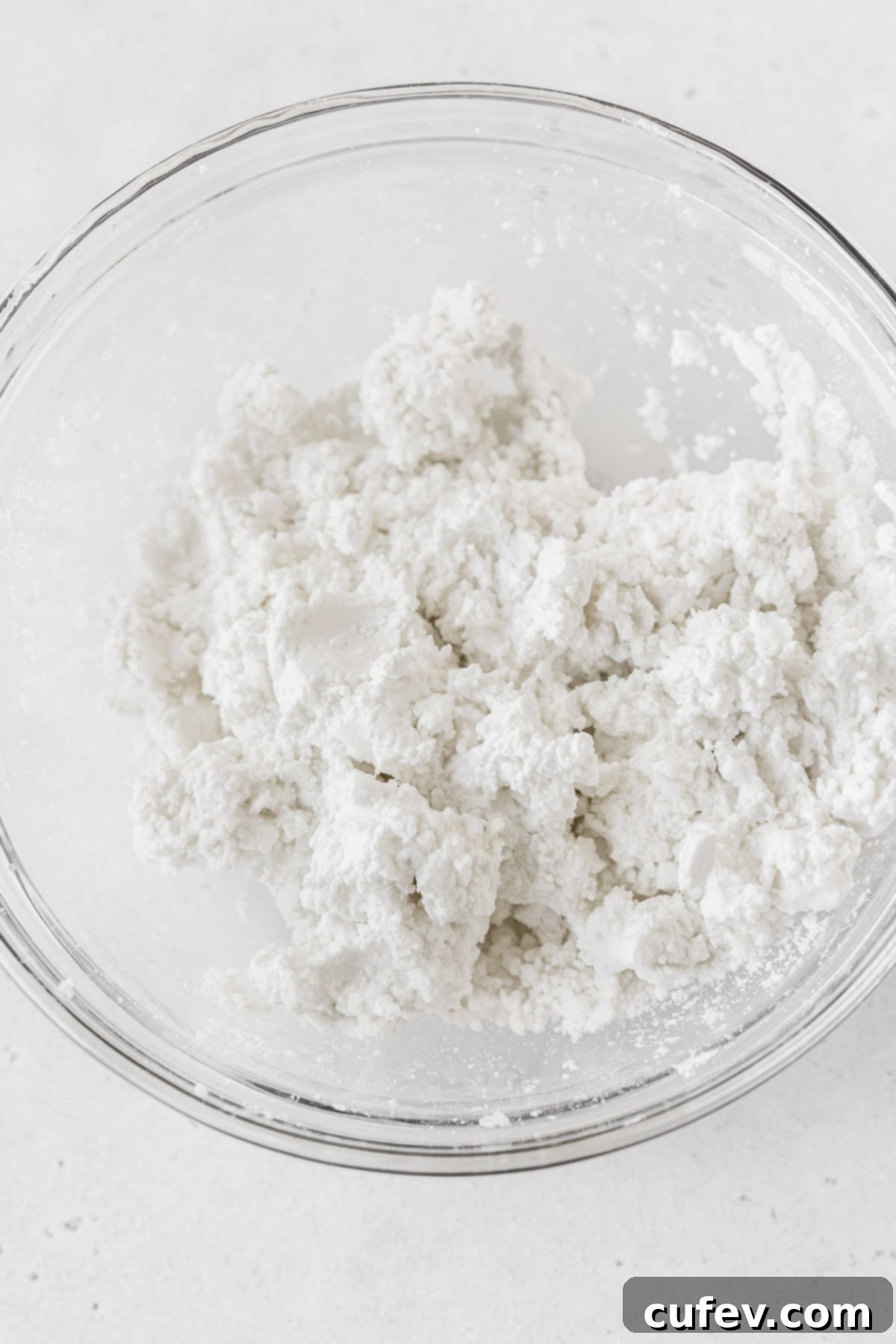

Step 3: Shape the Dango. Once your dough reaches the desired earlobe-like consistency, roll it into a uniform log. Then, using a knife or dough cutter, divide the log into 24 equally sized pieces. For ease of handling and to prevent sticking, prepare a plate lined with plastic wrap. Take each small piece of dough and, using both hands, gently roll it into a smooth ball. Place the formed balls onto your plastic-wrapped plate, ensuring they don’t touch each other. As an optional but recommended step, you can slightly flatten each ball and create a small indentation in the center with your finger. This indentation helps the dango cook more evenly and provides a charming little pocket for your delicious toppings.
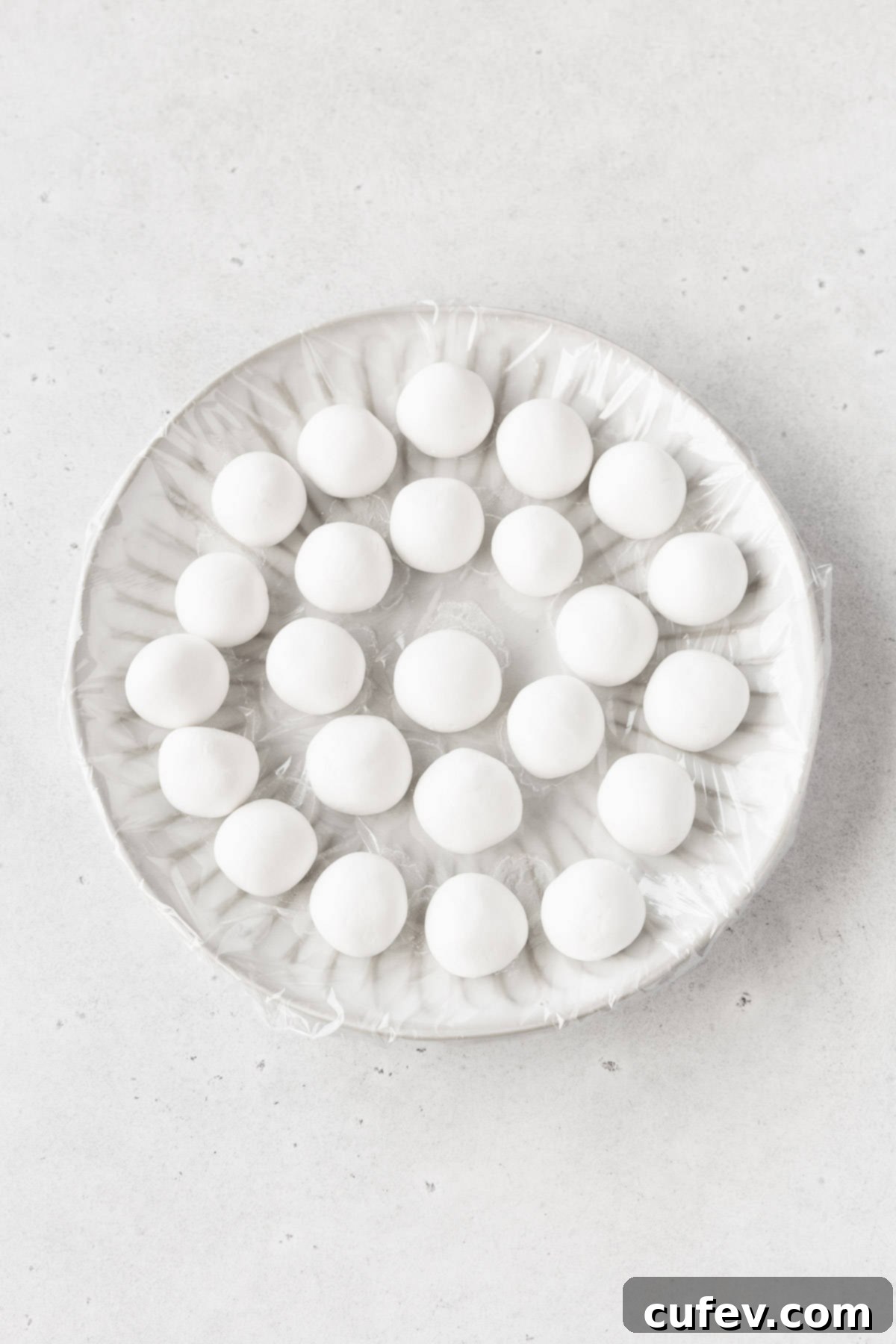
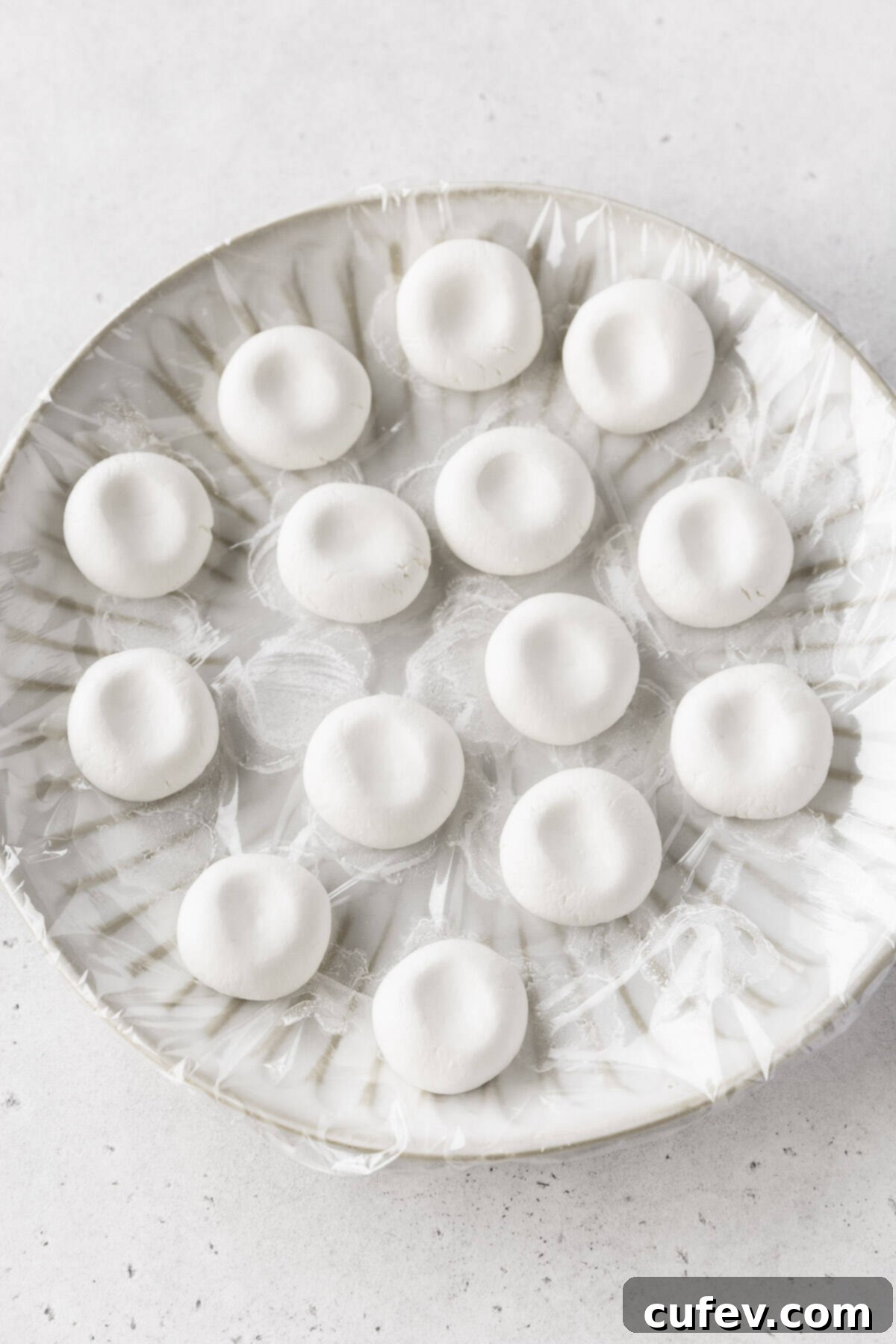
Step 4: Boil and Observe. Bring a pot of water to a rolling boil. Carefully drop the shaped shiratama dango into the boiling water. Reduce the heat to medium and continue to boil the dango. You’ll notice that as they cook, they will gradually float to the surface of the water, which typically takes about 4-5 minutes. Once they float, continue to cook them for an additional 1-2 minutes to ensure they are thoroughly cooked through and reach their optimal chewy texture.
Step 5: Chill and Serve. Using a slotted spoon, carefully remove the cooked dango from the hot water and immediately transfer them into a prepared bowl of ice water. This ice bath is crucial as it stops the cooking process, cools the dango rapidly, and helps them retain their desired chewy and bouncy texture. Allow them to chill completely in the ice water. Once fully chilled, drain the shiratama dango thoroughly and serve them promptly with your preferred toppings. Enjoy your perfectly homemade, fresh shiratama dango!
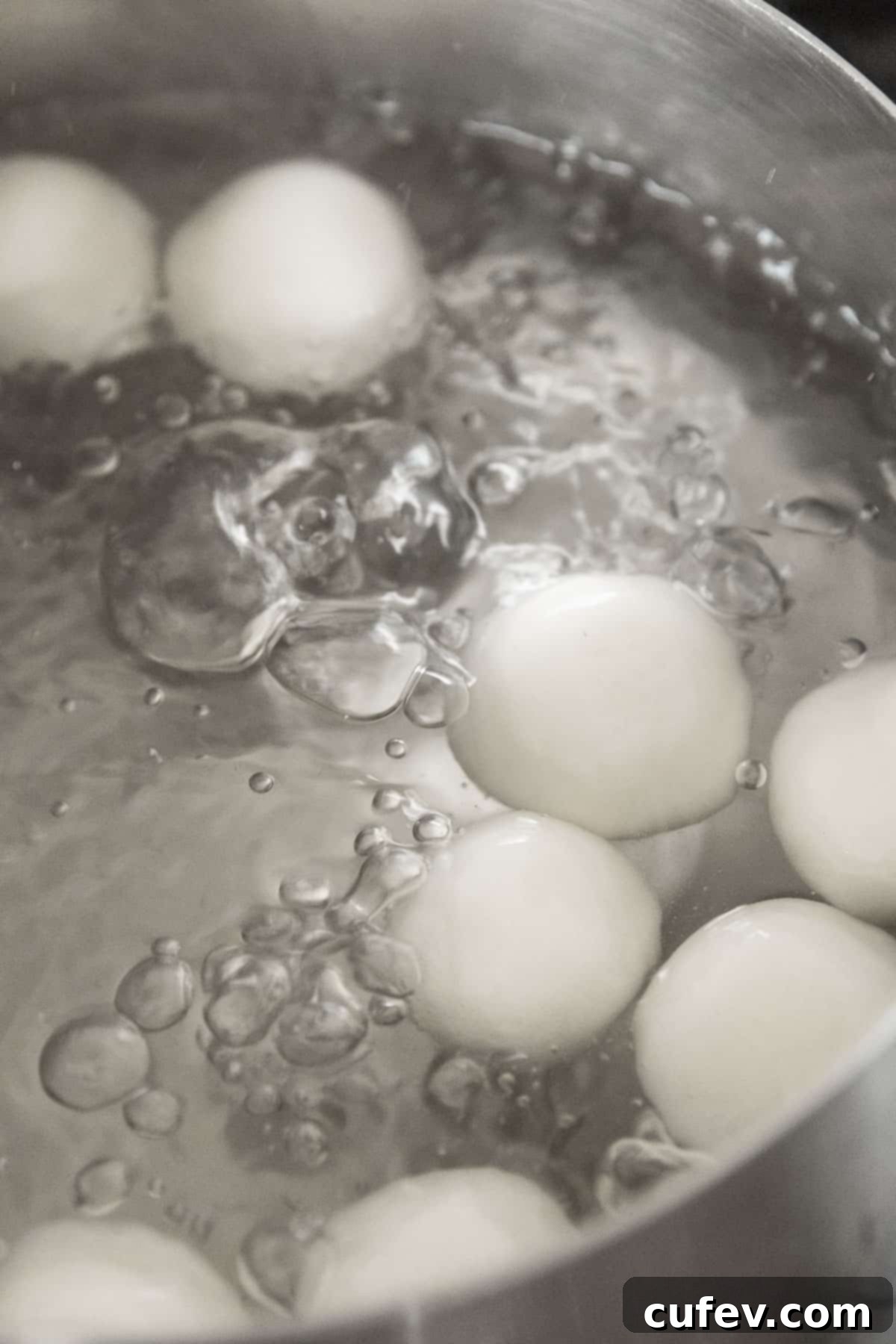

Using Mochiko Rice Flour for Dango: A Guide
While shiratamako is highly recommended for its superior texture in shiratama dango, mochiko is a more readily available alternative for many. If you decide to use mochiko instead of shiratamako, you’ll need to adjust the water content and expect a slightly different outcome. I recommend starting with half the amount of water specified in the recipe (approximately ¼ cup, or 60ml) and gradually adding more, a tablespoon at a time, until the dough just comes together. Mochiko tends to absorb water differently, so careful observation of the dough’s consistency is crucial. Shiratama made with shiratamako typically boasts a distinctly stretchy and smooth texture with a lovely shiny surface. In contrast, dango crafted with mochiko will generally be chewier, less smooth in consistency, and may have a slightly stronger, more prominent flavor of sticky rice. Experimentation can lead to a satisfying result, but be aware of these textural differences.
Expert Tips for Flawless Shiratama Dango
Achieving delicious and perfectly textured mochi dango every time is easy with a few expert insights. Keep these pro-tips in mind to elevate your shiratama dango making process:
- Mix and Knead the Dough with Your Hands: This is perhaps the most important tip. The tactile feedback from using your hands is invaluable. It allows you to truly feel the dough’s texture, ensuring it reaches that ideal “earlobe” consistency. A machine can’t replicate this nuanced feel, which is critical for the dango’s chewiness and smoothness. Don’t be afraid to get a little messy!
- Always Wrap Your Plate with Plastic Wrap: Mochi dough, especially shiratama dough, is incredibly sticky. If you place your freshly rolled dango balls directly onto a plate, they will undoubtedly adhere firmly. A simple layer of plastic wrap on your plate before placing the dough balls prevents this issue entirely, making cleanup and transfer much easier.
- Add an Indentation for Even Cooking: While optional, creating a small indentation in the center of each dango ball with your finger offers two significant benefits. Firstly, it helps the dango cook more evenly by allowing heat to penetrate the center more efficiently. Secondly, it creates a charming little “pocket” that is perfect for holding a dollop of sweet red bean paste, a sprinkle of kinako, or a pool of syrup, enhancing both presentation and flavor.
- Do Not Over-Boil the Dango: Boiling the shiratama dango for too long can have a detrimental effect on their texture. Over-boiled dango tend to absorb too much water, resulting in a soggy, waterlogged exterior and a less appealing, mushy chew rather than the desired bouncy texture. Keep an eye on them once they float, and stick to the recommended 1-2 minutes of additional cooking time.
- Don’t Keep Them in Ice Water for Too Long: Just as over-boiling can lead to sogginess, leaving the cooked shiratama dango to sit in the ice water bath for an extended period can also cause them to become waterlogged. The ice bath is for rapidly chilling them to stop the cooking and firm up their texture. Once they are thoroughly chilled, which typically takes only a few minutes, it’s best to drain them promptly to maintain their optimal consistency.

Delightful Serving Suggestions for Your Dango
Shiratama dango’s mild and delicate flavor makes them incredibly versatile, serving as a perfect base for a wide array of toppings and pairings. Here are some fantastic ideas to inspire your culinary creativity:
- Classic Kinako and Sugar: A timeless favorite! Gently dust your shiratama dango with fragrant kinako (roasted soybean powder) and a sprinkle of fine granulated sugar. The nutty aroma of kinako beautifully complements the dango’s subtle sweetness.
- Rich Anko (Sweet Red Bean Paste): For a truly traditional experience, serve your dango with a generous dollop of smooth or chunky anko. The earthy sweetness of the red bean paste is a match made in heaven with the chewy dango.
- On Top of Ice Cream: Elevate your dessert game by placing chilled shiratama dango on top of your favorite ice cream. Matcha ice cream is an especially popular and exquisite pairing, offering a delightful contrast in flavors and textures.
- A Drizzle of Sweet Syrup: Simple yet satisfying, a drizzle of maple syrup or traditional kuromitsu (Japanese black sugar syrup) adds a touch of luxurious sweetness. These syrups also add a beautiful glossy finish.
- Added to Sweet Red Bean Soup: Immerse your dango in a comforting bowl of zenzai or oshiruko, a warm, sweet red bean soup. The soft dango absorb some of the soup’s flavor while maintaining their chewy texture, creating a wonderfully hearty and traditional Japanese dessert. You can find a great recipe for this here.
- A Surprising Savory Twist: For an unconventional yet surprisingly delicious experience, try adding shiratama dango to certain savory dishes like miso soup. The unexpected chewiness can add an interesting textural dynamic to the traditional Japanese soup.
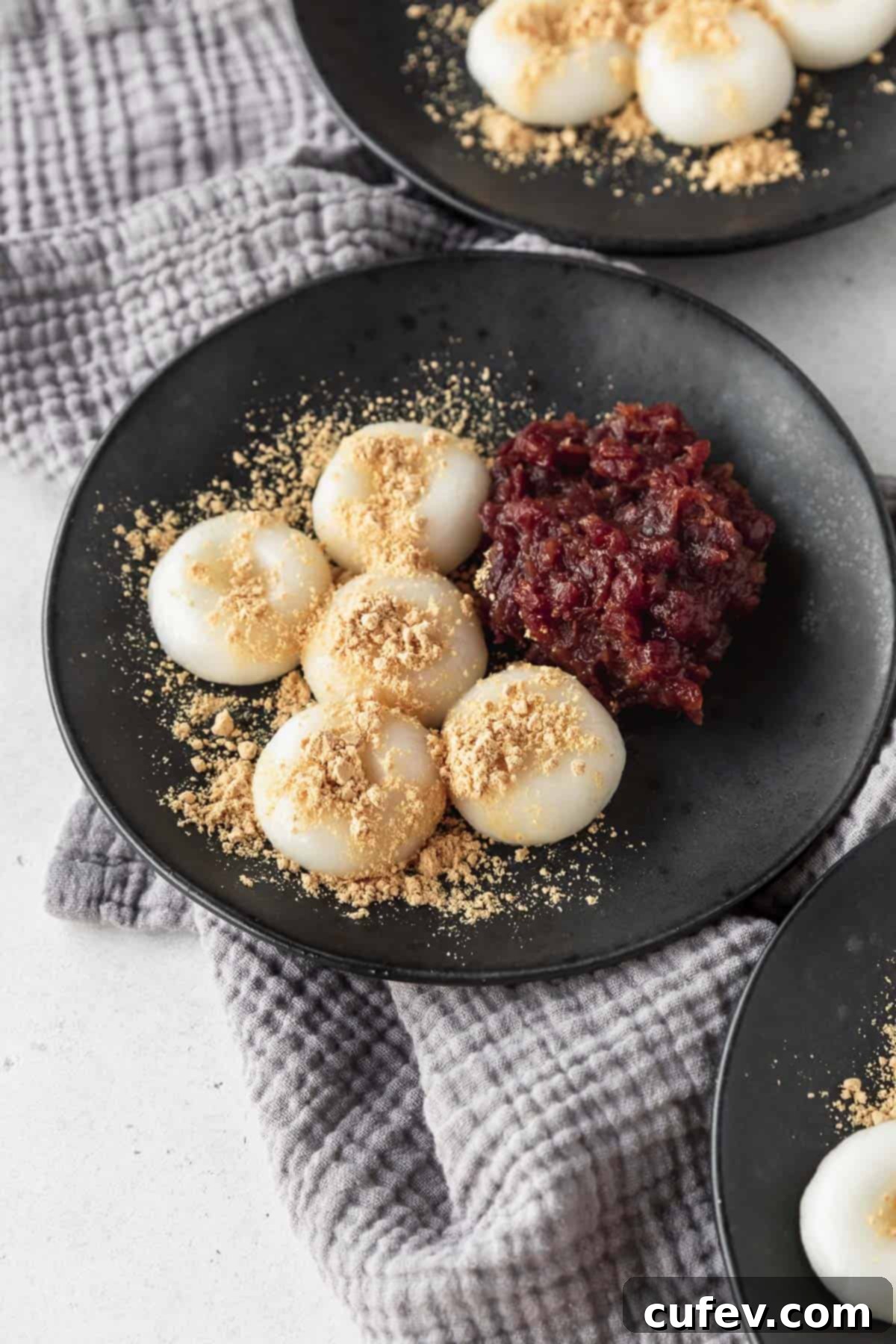
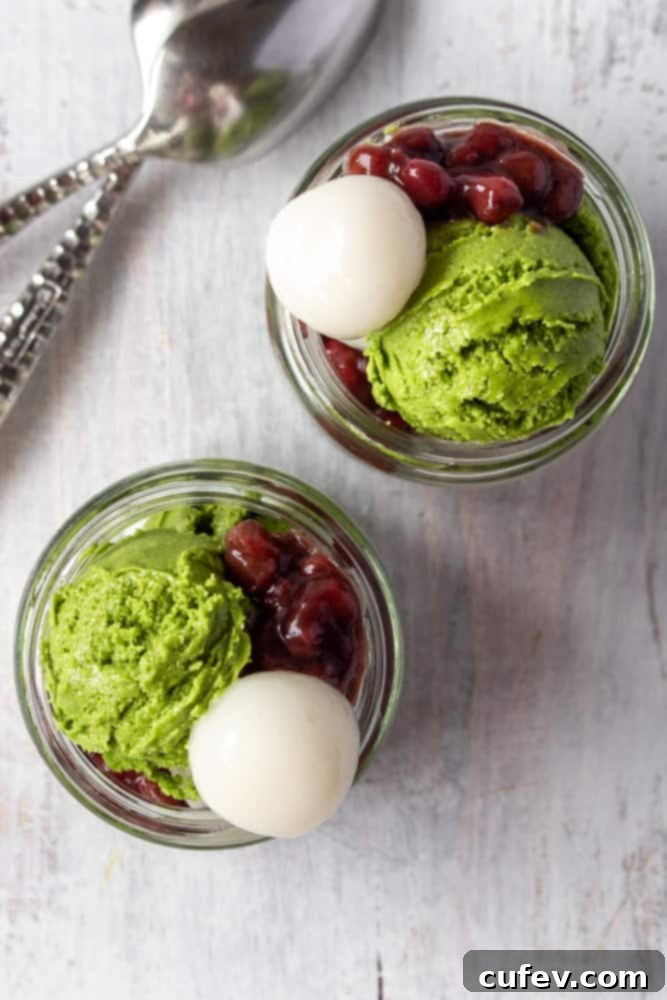
Storage and Freezing Techniques for Longevity
Shiratama dango are best enjoyed fresh, but they can be stored to extend their deliciousness. The key is to prevent them from drying out or becoming soggy, which can quickly alter their unique texture. Properly storing your dango ensures you can enjoy them for days or even weeks to come.
To store, take the cooled shiratama dango and arrange them on a piece of plastic wrap, ensuring about ½ inch of space between each dumpling. Carefully fit the plastic wrap tightly over and around each dango so they are individually covered and not touching each other. This prevents them from sticking together and helps retain their moisture. Once wrapped, place these plastic-covered dango into an airtight container or a freezer-safe bag.
You can keep the wrapped shiratama dango in the refrigerator for up to 1 week, maintaining a relatively fresh texture. For longer storage, they can be safely kept in the freezer for up to 1 month. It’s important to note that some people suggest storing dango in water, but this method is generally not recommended as it causes the shiratama to become waterlogged and lose its distinct mochi flavor and bouncy chewiness.
Reheating and Softening Stored Shiratama Dango
One common characteristic of mochi-based desserts like shiratama dango is that they tend to harden when refrigerated or frozen. This change in texture is completely normal and easily remedied. To restore their wonderfully soft and chewy consistency, it’s essential to gently heat them before serving.
There are a couple of effective methods for softening stored shiratama dango:
- Microwave Method: For a quick and convenient option, place the dango on a microwave-safe plate. Heat them in the microwave for short bursts (e.g., 10-15 seconds at a time) until they become soft and pliable again. Be careful not to overheat, as this can make them excessively sticky or tough.
- Boiling Water Method: For results closest to freshly made dango, bring a small pot of water to a boil. Carefully drop the hardened shiratama dango into the boiling water and cook for 1-2 minutes, or until they float and feel soft to the touch.
Once softened, you can enjoy them warm, which is particularly delightful with savory toppings or in soups. Alternatively, if you prefer them chilled (especially for fruit or ice cream pairings), place them back into a bowl of ice water for a few minutes after softening, then drain well before serving. This dual approach ensures your stored shiratama dango are just as enjoyable as when they were first made.
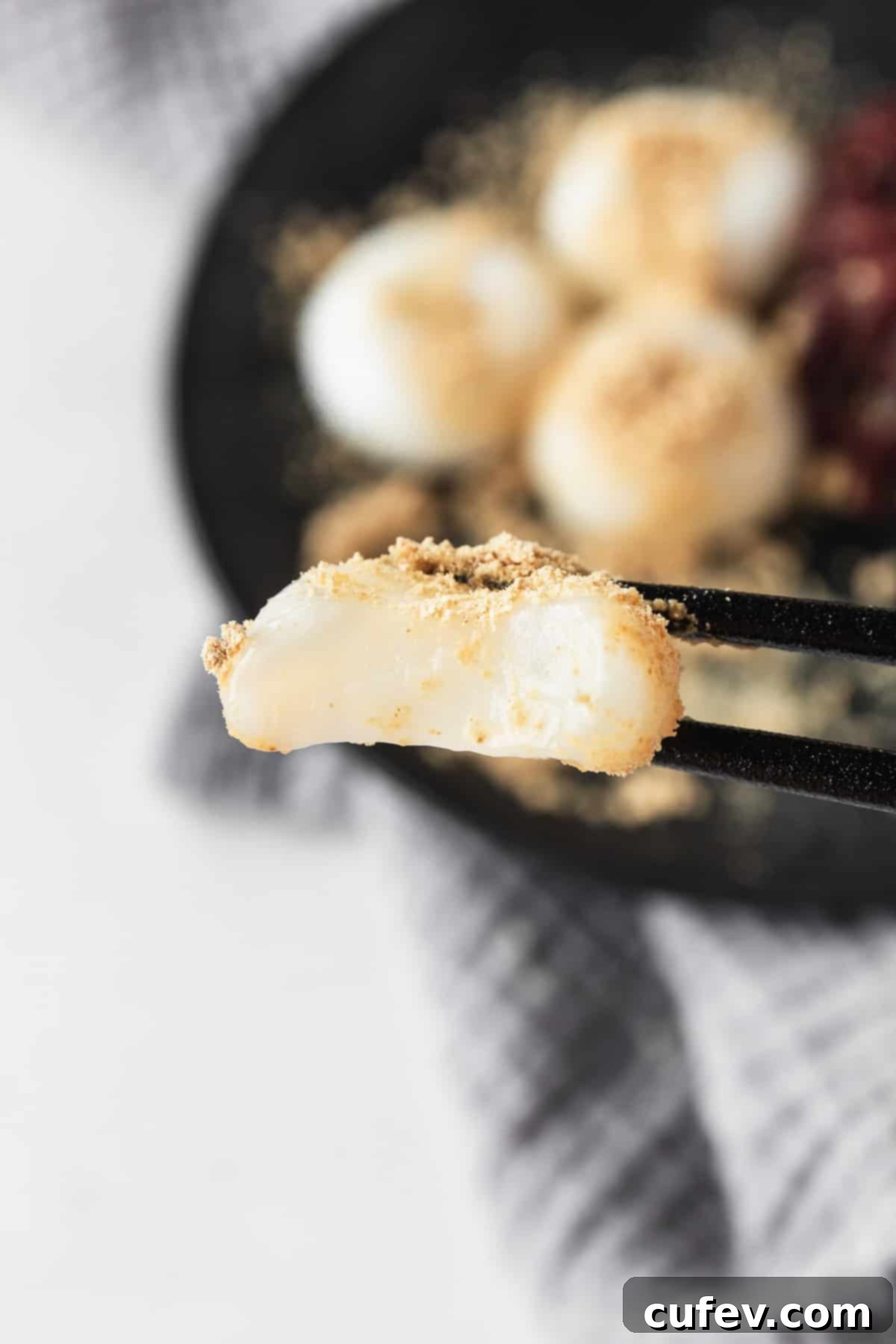
Frequently Asked Questions About Shiratama Dango
While often used interchangeably outside of Japan, mochi and dango are not precisely the same. Both are beloved types of Japanese sweets, known as wagashi, and are made from glutinous rice. However, traditionally, mochi is prepared by pounding steamed whole mochigome (sticky rice) until it forms a smooth, elastic mass. Dango, on the other hand, is typically made from rice flour (like shiratamako or mochiko) which is mixed with water to form a dough, then shaped and boiled or steamed. So, while dango is a type of rice dumpling, it’s distinct from the pounded whole-grain mochi. Outside of Japan, the term “mochi” has become a broad umbrella for many sticky rice-based desserts.
The ideal serving temperature for dango largely depends on the specific type and its accompanying flavors. These particular shiratama dango, with their delicate texture and subtle sweetness, are generally enjoyed cold, especially when paired with fresh fruits, ice cream, or chilled syrups. The cold temperature enhances their chewiness and refreshing quality. However, other varieties of dango, such as mitarashi dango, are skewered, grilled until slightly charred, and then served warm with a sweet soy glaze. So, while shiratama dango are typically enjoyed chilled, the answer isn’t universal across all dango types.
Absolutely! While traditional shiratama dango are kept neutral to highlight their texture and toppings, you can certainly incorporate flavors directly into the dough. Popular additions include a small amount of matcha powder for a vibrant green color and earthy taste, or cocoa powder for a chocolatey twist. You could also experiment with natural food colorings to create visually appealing, colorful dango. When adding powders, simply mix them in with the shiratamako before adding water, ensuring they are well-combined for even distribution.
Yes, traditional shiratama dango are inherently gluten-free! Shiratamako is made from glutinous rice, but “glutinous” in this context refers to its sticky, glue-like texture when cooked, not to the presence of dietary gluten (which is found in wheat, barley, and rye). Therefore, as long as you use pure shiratamako and ensure all your toppings and accompanying ingredients are also gluten-free, shiratama dango is a wonderful dessert option for those with gluten sensitivities or celiac disease.
Tools You’ll Need for Your Shiratama Dango
Making shiratama dango requires only a few basic kitchen tools, making it an accessible recipe for most home cooks:
- Mixing bowls: You’ll need at least one medium-sized bowl for preparing the dough and another bowl (or large container) for the ice bath.
- Pot: A medium to large pot is essential for boiling the dango. Ensure it’s large enough to hold the dango comfortably without overcrowding.
- Strainer or Slotted Spoon: A strainer or a slotted spoon is crucial for safely transferring the cooked dango from the boiling water to the ice bath.
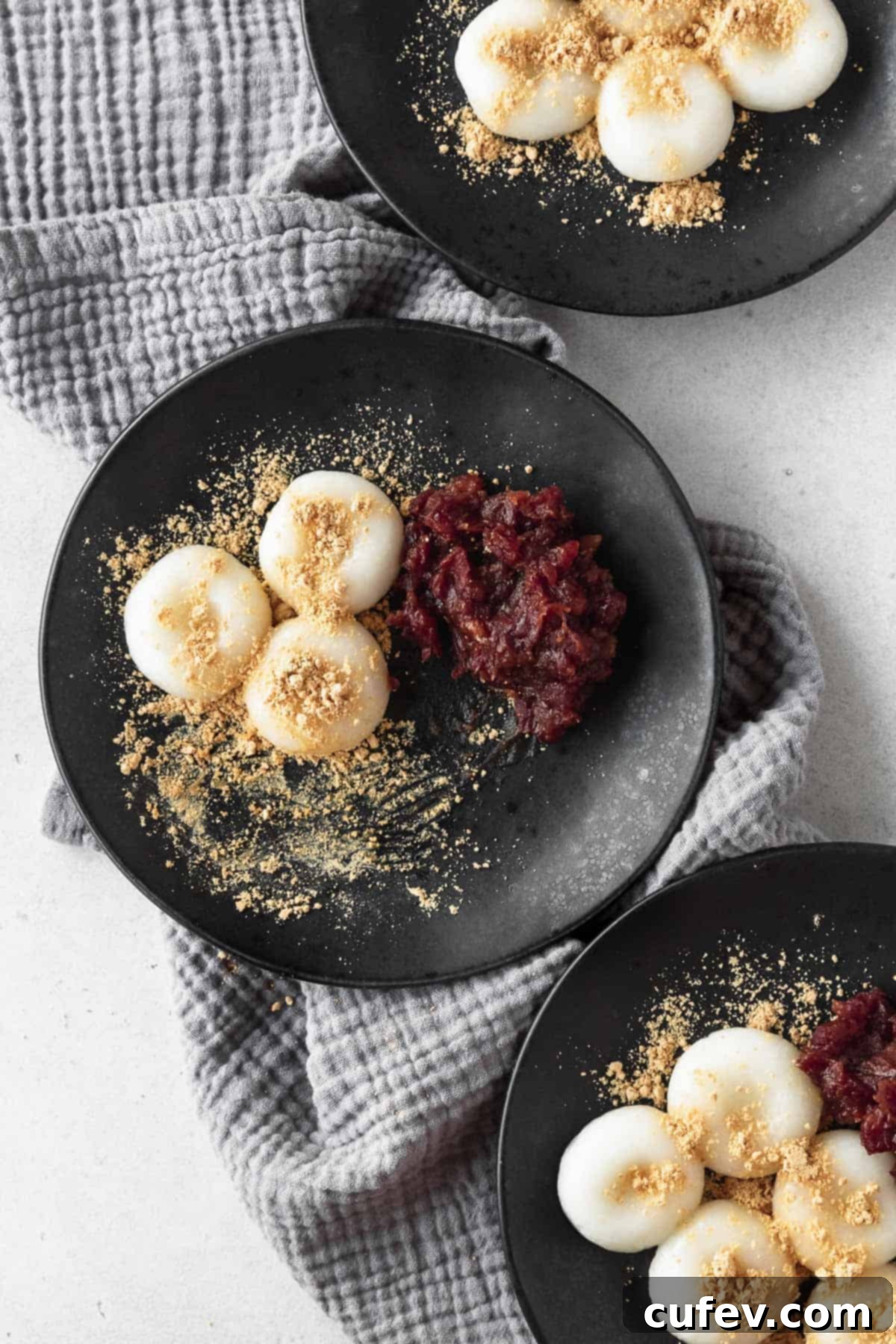
Explore More Japanese & Japanese-Inspired Desserts
If you enjoyed making and savoring these shiratama dango, you might be eager to explore other delightful Japanese and Japanese-inspired desserts. Here are a few more recipes that offer unique flavors and textures:
- Kashiwa Mochi: This is a quintessential Japanese dessert, famously served on Children’s Day. It features soft mochi filled with sweet red bean paste and elegantly wrapped in an oak leaf, imparting a subtle, earthy aroma.
- Sakura Mochi: Another beautiful mochi dessert, sakura mochi celebrates the cherry blossom season. It’s often pink-hued, filled with sweet bean paste, and wrapped in an edible pickled cherry blossom leaf, which adds a wonderful salty counterpoint to the sweetness.
- Matcha Cupcakes: For those who love the distinctive taste of matcha, these fluffy cupcakes are a perfect fusion. They are infused with sweet matcha flavor and often topped with a rich white chocolate frosting for a harmonious balance.
- Yuzu Cheesecake: This modern Japanese-inspired dessert combines the creamy indulgence of cheesecake with the vibrant, aromatic zest of yuzu, a Japanese citrus fruit. The luscious yuzu curd layer provides a refreshing tang that beautifully cuts through the richness of the cheesecake.

Shiratama Dango
Print
Pin
Rate
Ingredients
- 1 cup shiratamako
- ½ cup water
Topping Ideas
- kinako
- sweet red bean paste
- kuromitsu syrup
- maple syrup
- matcha ice cream
Instructions
-
Begin by bringing a pot of water to a vigorous boil. While the water heats, prepare a separate bowl filled with ice water, which will be used to chill the dango after cooking.
-
In a mixing bowl, combine the shiratamako with approximately half of the measured water. Mix thoroughly with your hand until the flour is mostly hydrated. Gradually add the remaining water, kneading continuously by hand until the mixture forms a smooth, pliable dough with a consistency similar to your earlobe.
-
Roll the prepared dough into a log shape, then divide it into 24 equal pieces. Using both hands, roll each piece into a small, smooth ball. For even cooking and to hold toppings, gently flatten each ball and create a small indentation in the center with your finger.
-
Carefully add the shaped shiratama dango to the boiling water. Reduce the heat to medium. Boil the dango until they float to the top, which usually takes about 4-5 minutes. Continue cooking for an additional 1-2 minutes to ensure they are fully cooked. Immediately transfer the cooked dango from the hot water into the ice water bath to chill completely.
-
Once the shiratama dango are thoroughly chilled, drain them well. Serve them immediately with your chosen toppings for a delightful Japanese sweet treat!
Notes
How to make shiratama with mochiko: If using mochiko, start with half the amount of water (¼ cup, or 60ml) and gradually add more to the mixture just until the dough comes together, as mochiko absorbs water differently than shiratamako.
Nutrition
Links included in this post might be affiliate links. If you purchase a product using these links I may receive a small commission. There is no additional charge to you 🙂
